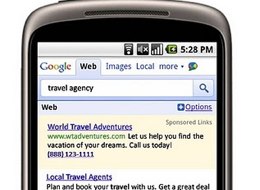 Not only has Google’s mobile search volume grown more than fivefold over the course of the last two years, but the clickthrough rates for its click-to-call mobile ads do 6-8% better than search ads without a number or URL associated with it, according to Mike Steib, director of emerging platforms at Google.
Not only has Google’s mobile search volume grown more than fivefold over the course of the last two years, but the clickthrough rates for its click-to-call mobile ads do 6-8% better than search ads without a number or URL associated with it, according to Mike Steib, director of emerging platforms at Google.
Steib, who participated in a panel today at PaidContent2010 Mobile Conference in New York, said that 2010 just might be the year that mobile takes off. “We’re seeing lots and lots of search activity on smartphones.”
Turning to Rachel Pasqua, the director of the mobile group at iCrossing, Steib joked about turning the panel into a business meeting and encouraged her to buy more ads for their clients. Pasqua responded by saying that many of her clients have been very happy with the ads and have had “tremendous success.”
We have heard the phrase “Year of Mobile” in years past, and yet predictions have repeatedly failed to satisfy the hype — at least until 2010. In the first three months of this year, for example, users with smartphones searched 62% more than they did in the previous three months. Search on Android devices has grown 300% in the first half of 2010 with about 160,000 new Android devices being activated everyday.
Although Steib wouldn’t specify the exact numbers, he did say that tens of millions of people make searches through Google on mobile devices each week, generating hundreds of millions of searches. And iPhone users, who dominate the smartphone market, are performing 50 times more searches than users of standard mobile features.
Mobile ads are doing better too, Steib said, especially click-to-call ads, which enable advertisers to add phone numbers to their ads. Advertisers are able to track how many calls they are getting per keyword, ad group or campaign. The click-to-call campaigns with location extensions or URLs increase 8% in average clickthrough rates, and campaigns with phone numbers perform 6% better than mobile ads without an extension.
It makes sense; businesses get a direct call from a potential customer or a click to their website. The biggest differentiator between desktop and mobile ads is location targeting. If users search for something on a mobile app, they are “astronomically” more likely to click on the ad presented to them if it is for a nearby business.
Google expanded the click-to-call campaign by offering it to local advertisers in addition to national ones just four months ago, so perhaps the increase in click-through rates is being affected by the large advertisers.
When asked about the looming Apple’s iAd product, Steib said it will be a great solution as long as it is part of a menu of choices. He said that publishers will likely be interested in iAds, but will want to have an array of choices for advertising to be able to reach their audience.
Source: Mashable.com

